How John Deere’s AI technology reduces inputs for cotton, other row crops
02 June 2022
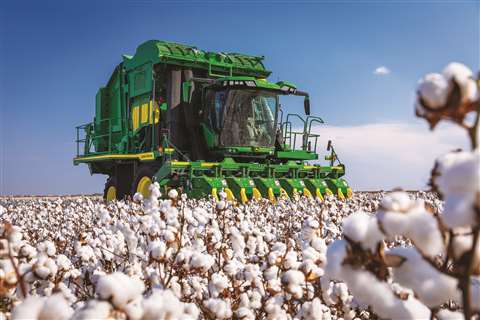 John Deere CP770 cotton picker. (Photo: Deere)
John Deere CP770 cotton picker. (Photo: Deere)
Technology that could have been imagined for a science fiction novel is transforming the way food is grown in the non-fiction world. Deere & Co. is helping drive that evolution by developing cutting-edge systems based on its work alongside growers and the study of years of agronomic and machine data – while at the same time expanding its expertise and its global footprint through strategic partnerships and acquisitions. For example, it got an address in California’s innovation-driven Silicon Valley when it purchased Blue River Technology. Now, See & Spray Ultimate – a system perfected by both firms to help reduce inputs – is ready for the market.
“We’ve been on a technology journey with our customers since broadcast spraying,” said Franklin Peitz, marketing manager for John Deere. “We moved to a zone focus with section control and then advanced to individual row control with ExactApply. We’re excited to optimize each individual plant using See & Spray’s artificial intelligence and machine learning.”
Based in Sunnyvale, Calif., Blue River first focused on the development of computer vision for lettuce growers and then got national attention when it applied machine learning to row crops such as cotton.
Kathleen Sprouse was introduced to the company while working in Salinas, Calif., for one of the country’s largest growers of salad ingredients.
“I actually called Blue River and asked them, ‘Can I join your team? I think you guys are the future,’” said Sprouse, who was hired in 2018 and is now senior product marketing manager.
By the time Blue River became a wholly owned subsidiary of Deere in 2017, its work on cameras and processors had evolved into a thinning and weeding service for local row crop farmers.
“When Blue River started in 2012, the focus was really on computer vision,” said Sprouse. “We designed custom cameras to see multiple bands of light so we could make sure we’re getting the best visibility out in the field. When we pair that with our suite of technology – artificial intelligence based on machine learning – the sprayer can see this is a weed and that is a crop and then just spray the weed.”
It essentially used facial recognition to identify weeds between green crops and only spray the unwanted plants. At first, a 12-row unit was mounted on the rear three-point hitch of a tractor for field trials and demonstrations, but growers told them it would be even better if it was part of a self-propelled sprayer. John Deere helped make that possible.
John Deere launched See & Spray Select in March 2021, a system that built on its ExactApply individual row control offering and was created with the University of Southern Queensland. The system uses camera technology to detect different colors along fallow ground and then trigger an application of herbicide only to those unwanted plants.
See & Spray Select can be factory-installed starting with 2022 John Deere 400 and 600 Series sprayers, which include the 408R, 410R, 412R, 612R and 616R.
Green on green on green
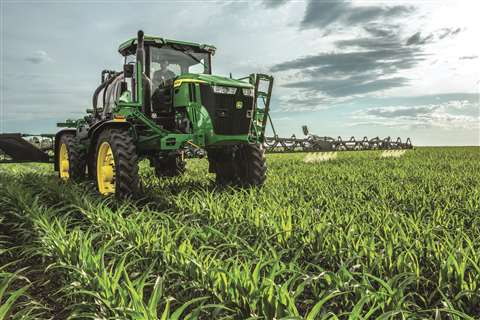 With sprayers equipped with See & Spray Ultimate, growers can automatically spot-spray weeds growing among green crops. (Photo: Deere)
With sprayers equipped with See & Spray Ultimate, growers can automatically spot-spray weeds growing among green crops. (Photo: Deere)
In March of this year, Deere rolled out See & Spray Ultimate, a completely different system from See & Spray Select. It is based on technology developed and perfected over the past several years by Blue River. Factory installed on Deere’s self-propelled sprayers, it handles the targeted spraying of non-residual herbicide on weeds growing among corn, soybean and cotton. The company said it can help the farmer reduce chemical inputs by as much as 2/3rds.
The system will be available on 2023 John Deere 410R, 412R and 612R sprayers equipped with a 120-ft. carbon-fiber truss-style boom; the boom is a requirement to ensure camera stability.
Cameras and processors use computer vision and machine learning to detect weeds growing among crop plants. One camera is mounted every 1 m across the width of the boom, for a total of 36 cameras on a 120-ft. boom to scanning more than 2100 sq. ft. at a travel speed as high as 12 mph.
The company said the system can help growers control weeds and battle herbicide resistance. “Farmers can apply a residual broadcast application and non-residual targeted application in a pre-emergence pass or targeted spray only as a clean-up pass,” said Peitz. “This also allows farmers to rethink their fungicide and liquid fertilizer passes. From a sustainability standpoint, See & Spray Ultimate can help farmers use less herbicide and decrease opportunities for drift, and that’s better for everyone.”
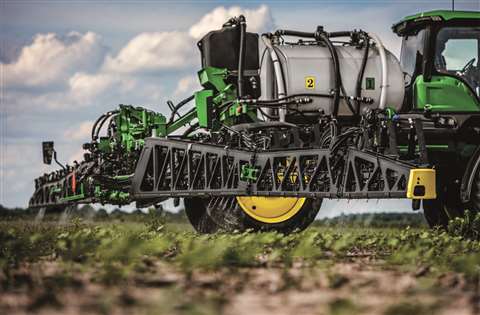 See & Spray Ultimate must be paired with Deere’s 120-ft. carbon fiber boom. The sprayers also get a split tank with dual-product capability. Two tank options are available: a 1200 gal. split into a 450-gal. tank for targeted spraying and a 750-gal. tank for broadcast spraying, and a 1000-gal. option split into a 350-gal. tank for targeted spraying and a 650-gal. tank for broadcasting. (Photo: Deere)
See & Spray Ultimate must be paired with Deere’s 120-ft. carbon fiber boom. The sprayers also get a split tank with dual-product capability. Two tank options are available: a 1200 gal. split into a 450-gal. tank for targeted spraying and a 750-gal. tank for broadcast spraying, and a 1000-gal. option split into a 350-gal. tank for targeted spraying and a 650-gal. tank for broadcasting. (Photo: Deere)
The 2023 sprayers are factory-equipped with a JDLink connection, plus a new integrated StarFire 7000 GPS receiver, and Generation 4 CommandCenter display. The StarFire 7000 receiver uses a new RTK signal, SF-RTK, which relies solely on satellite communication. Deere said by combining all of these technologies, the operator can reduce overlap and maximize inputs with less stress.
When a sprayer equipped with See & Spray Ultimate travels across the field, the Generation 4 display shows how much ground was covered and what was sprayed. Because See & Spray Ultimate is integrated into the John Deere Operations Center, after a pass is made, a map is generated that shows weed pressure. Farmers can compare the weed map to their yield map and make field management decisions.
“The machine is able to identify the crop and specifically target weeds as small as a blade of grass,” said Sam Sparks, a third-generation farmer in the Rio Grande Valley in Texas, where he grows cotton, corn, sorghum, soybeans, sesame and sugar cane. He worked with Deere to run field tests with a See & Spray Ultimate sprayer and said the savings can go beyond chemicals.
“The savings starts with your labor, because you’re not having to stop and fill up the machine as often,” said Sparks. “They’re out in the field spraying longer so your time spraying is more efficient. If you’re going to be a productive farmer, a successful farmer, timing is everything. If you’re out in the field targeting these nuisance weeds — versus stopped filling up — you’re taking care of your crops and the environment. It really is the definition of the future of agriculture.”
Fast to market
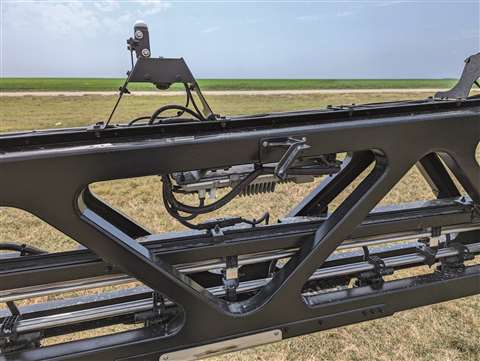 Cameras and processors mounted along the boom scan 2100 sq. ft. while the sprayer travels at up to 12 mph. (Photo: Chad Elmore)
Cameras and processors mounted along the boom scan 2100 sq. ft. while the sprayer travels at up to 12 mph. (Photo: Chad Elmore)
Developing such technology for row crop farming poses challenges that are quite different from those faced in industries such as quarries and mines – field testing and product demonstrations cannot be performed in the field all day every day, but only when the crops are growing. The work involves collaborating with growers in different climate zones as well as universities and seed and fertilizer companies.
“We’re always working for that balance of system performance and development speed by constantly iterating with our customers,” said Sprouse. “Being fast to market is really important. We started talking about this technology back in 2019 and had a video game that simulated a sprayer driving through the field. We met with customers on their farm to talk about the concept and the savings we expected them to see. That iteration with customers really helps to move the technology along faster by showing them something to get their feedback rather than just showing up to talk. We’re constantly working with customers and stakeholders to make sure we’re delivering the solution that they’re looking for.
“We can move really fast because we have really great partners such as growers and universities who are willing to work with us at each stage of the development and give feedback. We also have the flexibility of having our test farm in California, where we have pretty good weather almost year-round. We also typically contract and grow on some acreage in south Texas. That’s usually the first crop to come out of the ground and then we’ll also do late-season planting. We make sure we have enough fields with crops growing for engineering to do testing in addition.”
Chad Yagow, who has degrees in agronomy and engineering and is now John Deere’s manager of AV&V Tactical Support and Planning, said the development of See & Spray Ultimate was “about getting out into as many environments as you can and collecting enough images to be able to train the system effectively. It really comes down to image processing and training the computer through image detection. We used a system mounted on backpacks, Gators and tractors and the images collected from sprayers as we were going through the fields.”
Cotton growing system
About a year and a half ago, Deere began to think in terms of a complete crop production system rather than individual product lines. As part of that effort, it hosts LEAD (Leading Economic & Agronomic Decisions) events throughout the country. It recently held one around a cotton gin on a portion of the 825000-acre King Ranch in south Texas where cotton and milo are the primary crops. Dealers and cotton growers attended the program that showcased the agronomic advantages of using Deere’s cotton production solution.
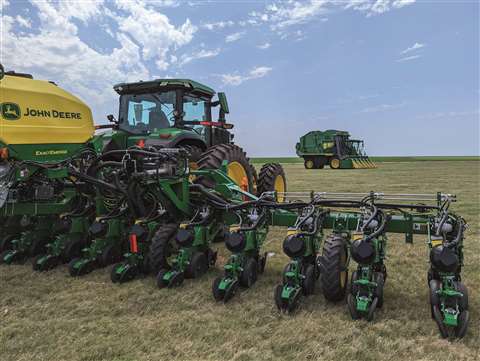 Deere is now thinking in terms of a complete crop production system rather than individual product lines. In cotton, that system can include the CP770 cotton picker, 8R tractor and 1725 planter. (Photo: Chad Elmore)
Deere is now thinking in terms of a complete crop production system rather than individual product lines. In cotton, that system can include the CP770 cotton picker, 8R tractor and 1725 planter. (Photo: Chad Elmore)
The event provided a look at See & Spray Ultimate on a 412R sprayer as well as the CP770 cotton picker, 8R tractor, 1725 planter and 2680H high performance disk.
For Deere, the system strategy has as much to do with the agronomic aspect of growing crops as the design of the iron and software. “As we look at things from a production system standpoint,” said Yagow, “we work to understand it from the time you prep the ground, put the seed in the ground and all the way after you harvest.
“By focusing on the production systems, we’re looking at cotton production in Texas or the Delta, corn and soybean production systems in the Midwest or soybean and corn and cotton production in Brazil, even small grains in Europe. We’ve got teams that are focused on those high dollar, high acre production systems that serve the majority of our customers. We’ve also been looking at dairy and livestock production to understand where we can better serve customers.”
The only cotton-focused components in Deere’s cotton harvest system are the new picker and stripper. Manufactured at Deere’s factory in Ankeny, Iowa (where the sprayers are also built), the machines can help farmers harvest every pound of seed cotton while preserving cotton quality from the field to the gin floor. The machines are 75% new compared to the previous model.
‘These cotton harvesters are mostly all-new from the ground-up and represent a strong platform John Deere should be able to utilize for many years,” said Christopher Murray, John Deere product marketing manager. “An all-new mainframe provides a solid foundation for each machine and includes an all-new cab and power module. John Deere also increased the size of the new round module builders on the picker and stripper, making it possible to harvest more acres per hour.”
Its third-generation round module harvester, the company said the CP770 carries on the field-proven tradition of its predecessors while using a new round module builder capable of making modules 2% larger and 5% more dense. Once the cotton is collected, the CP770 wraps and ejects the module in about 30 seconds for non-stop cotton harvesting.
“We have a very close working relationship with our cotton customers,” said Murray. “Our 7760 cotton picker went to full production in 2009 and we’ve learned a lot from 2009 to today. By working with our customers and understanding their plans for the future and understanding their integration of technology, we saw an opportunity to take what we’ve learned and build a new foundation to grow off of as we look toward the future.“
The cotton machine gets a new cab that the company said is larger, quieter and more comfortable than previous models, and provides operators with visibility aided by strategically placed cameras, mirrors and lighting.
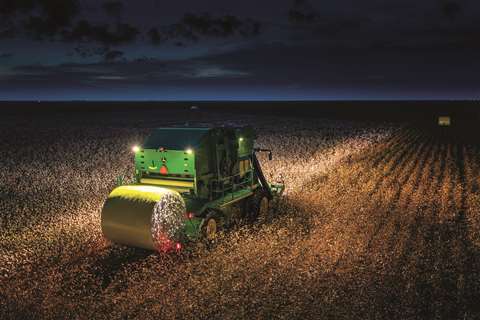 The new cotton harvesters are 75% new compared to the previous model. (Photo: Deere)
The new cotton harvesters are 75% new compared to the previous model. (Photo: Deere)
“We’ve also brought that technology integration inside that cab,” said Murray, “truly giving farmers the visibility in real time to see what’s going on around the harvester, then also off-boarding that to a farm manager, agronomist or seed sales rep.”
As the cotton bales are made, John Deere Harvest Identification Cotton Pro uses a radio-frequency identification (RFID) reader on the cotton picker or stripper to read the module serial number off tags that are embedded in the module wrap. The module serial number is combined with the client, farm, field, variety and machine identifier plus the date, time and GPS position of where the module was wrapped.
“Tagging modules provides that traceability for that cotton,” said Murray. “In cotton, productivity and quality is extremely important. Cotton, unlike grain, is not all about volume. There is that aspect, too, but cotton is graded when it goes to the gin, and farmers get paid based on the quality of cotton they have. Making sure that we can get that cotton harvested in a timely fashion and protected in that round module is very important so that once it’s ginned, the customer gets the top price for their cotton and these machines provide that increased productivity to protect cotton quality.”
To document and capture harvesting data and for traceability purposes, John Deere offers integrated technology for the CP770 and the CS770 by equipping each with a Generation 4 display. JDLink Connection is also included at no additional charge, making it easy for famers to connect to their machines while enabling automatic data flow between their equipment and the John Deere Operations Center.
“Cotton is one of the only crops that can be fully traced from where it came from in a given field, through the gin, to the mill. Exclusive John Deere Harvest Identification Cotton Pro technology makes this possible,” Murray said. “Although the industry does not yet mandate this level of traceability, it’s likely to become common in the future and both the CP770 and CS770 are fully prepared to meet those needs.”
A new John Deere 14P 13.6 L PowerTech engine rated at 550 hp with a single wastegate turbocharger, which is also used in the company’s combines and four-wheel-drive tractors, and hydraulic power module improve fuel efficiency by up to 20% for the CP770 and up to 15% for the CS770, while reducing maintenance requirements and costs.
“We packaged the engine in a power module in the belly of the frame with a reversible fan to keep the cooling cores,” said Murray. “It’s looking at cooling temperature, hydraulic oil, temperature, ambient air temperature and will reverse as needed. It’s all in a much cleaner packaging than what we had before, it’s easier to maintain and it’s less complex. That new engine is also quieter. It runs at 1900 rpm versus 2100, which means it’s quieter and more efficient.”
When equipped with the new 12-row SH12F folding header, the CS770 is up to 48% more productive in harvesting dryland cotton compared to the CS690 eight-row harvester. “This productivity increase helps customers harvest up to 100 more acres per day in a 10-hour day than they previously could with prior eight-row strippers,” Murray said.
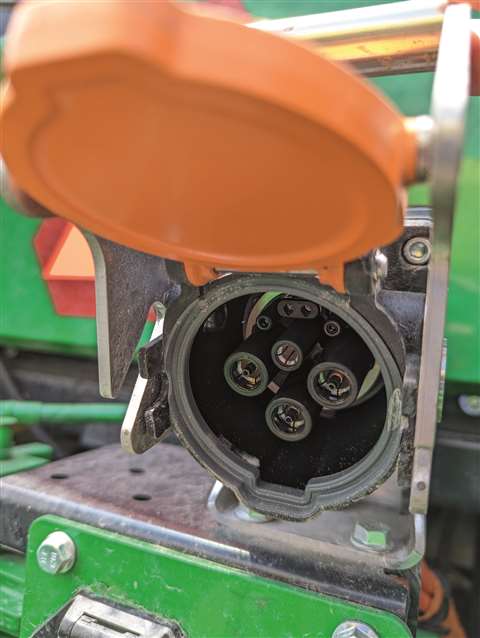 EVT-equipped 8 Series tractors will be capable of offboarding electricity to power implements. (Photo: Chad Elmore)
EVT-equipped 8 Series tractors will be capable of offboarding electricity to power implements. (Photo: Chad Elmore)
“An EVT has two electric motor generators in place of the hydrostatic motors that improve transmission performance, reliability and increase efficiency,” said Ryan Jardon, marketing manager for John Deere. “The EVT brings everything customers appreciate from an Infinitely Variable Transmission (IVT), into higher horsepower 8 Series tractors. Inherently, the electrical components of an EVT are extremely reliable, offer tremendous longevity and provide better overall tractor control, along with a system built for easy serviceability and diagnostics. In addition, customers will notice an EVT operates more quietly than an IVT.”
EVT also enables electric power generation, giving the industry an opportunity to leverage power produced by the tractor for new implements.
“In the future, EVT-equipped 8 Series tractors will optionally feature electric power generation capable of offboarding electricity to power implements,” Jardon said. “This EVT is the industry’s only transmission that enables electric power generation [up to 100 kW]. By using this electricity, farmers could power implement fan drives, take the place of implement hydraulic pumps, or assist the tractor by powering the implement’s axles.”
While the feature may lead to new farm implement designs in Canada and the United States, pull-type equipment with powered axles is being used in Europe to help push the tractor from behind while working in the field.
“EVT technology offboards electricity from the tractor to provide added power to the implement and can reduce wheel slip, improve uphill performance and enable the tractor to pull wide implements without the need for extra ballast or a larger tractor,” Jardon said.
“Today a PTO, Power-beyond [pressurized hydraulic oil] and SCVs [rear section control valves] are the main outlets of power out of the back of the tractor. The EVT will now give you higher amounts of electricity to leverage. There’s currently no U.S. or Canada solutions on the market to leverage this technology. But it’s something that a lot of folks are looking at. And if there are other implement manufacturers that are looking to explore it, we certainly invite them to reach out to us because we’d like to talk.”
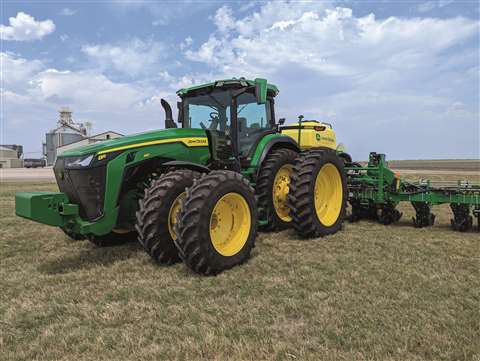 An EVT has been seamlessly integrated into this John Deere 8R 410 tractor. (Photo: Chad Elmore)
An EVT has been seamlessly integrated into this John Deere 8R 410 tractor. (Photo: Chad Elmore)
The technology used in the EVT has been proven through installations in John Deere’s construction and forestry equipment and will be available on model year 2023 tractors.
“From a diagnostic perspective, because they’re electrical and electrically controlled, we have a lot more feedback coming back into the control systems that help from a diagnostic standpoint,” said Jardon. “We’ve got better feedback into what the transmission’s doing and then any potential issues that might pop up.”
According to Jardon, ideal jobs for the EVT include “high-speed transport and high-speed planting applications and anywhere where you might want really precise speed control.”
STAY CONNECTED




Receive the information you need when you need it through our world-leading magazines, newsletters and daily briefings.
POWER SOURCING GUIDE
The trusted reference and buyer’s guide for 83 years
The original “desktop search engine,” guiding nearly 10,000 users in more than 90 countries it is the primary reference for specifications and details on all the components that go into engine systems.
Visit Now
CONNECT WITH THE TEAM










